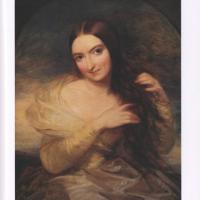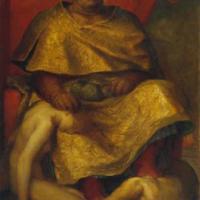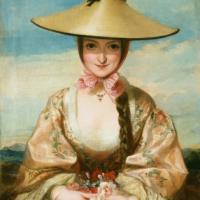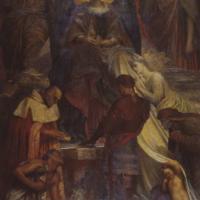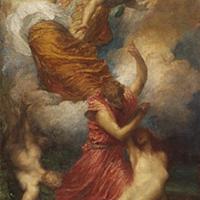George Frederic Watts
Eve Tempted
$450.00
Lady Mary Augusta Holland
$450.00
Mammon
$450.00
Mary Augusta, Lady Holland
$450.00
The Court Of Death
$450.00
The Creation Of Eve
$450.00
George Frederic Watts
George Frederic Watts (1817-1904)
George Frederic Watts, OM (London 23 February 1817 – 1 July 1904) was an English Victorian painter and sculptor associated with the Symbolist movement. He said "I paint ideas, not things." Watts became famous in his lifetime for his allegorical works, such as Hope and Love and Life. These paintings were intended to form part of an epic symbolic cycle called the "House of Life", in which the emotions and aspirations of life would all be represented in a universal symbolic language.
Watts was born in Marylebone in central London on the birthday of George Frederic Handel (after whom he was named), to the second wife of a poor piano-maker. Delicate in health and with his mother dying while he was still young, he was home-schooled by his father in a conservative interpretation of Christianity as well as via the classics such as the Iliad. The former put him off conventional religion for life, while the latter was a continual influence on his art. He showed artistic promise very early, learning sculpture from the age of 10 with William Behnes, starting to study devotedly the Elgin Marbles (later writing "It was from them alone that I learned") and then enrolling as a student at the Royal Academyat the age of 18. He first exhibited at the Academy in 1837. He also began his portraiture career, receiving patronage from his close contemporary Alexander Constantine Ionides, who later came to be a close friend.
The prize from the Westminster competition did, however, fund a long visit to Italy from 1843 onwards, where Watts stayed and became friends with the British ambassador Henry Fox, 4th Baron Holland and his wife Augusta at their homes in Casa Feroni and the Villa Careggi. Also while in Italy Watts began producing landscapes and was inspired by Michelangelo's Sistine Chapel and Giotto's Scrovegni Chapel. In 1847, while still in Italy, Watts entered a new competition for the Houses of Parliament with his image of Alfred the Great, Alfred Inciting the Saxons to Prevent the Landing of the Danes by Encountering them at Sea, on a patriotic subject but using Phidean inspiration. Leaving Florence in April 1847 for what was intended to be a brief return to London, he ended up staying. Back in Britain he was unable to obtain a building in which to carry out his plan of a grand fresco based on his Italian experiences, though he did produce a 45 ft by 40 ft fresco on the upper part of the east wall of the Great Hall of Lincoln's Inn entitled Justice, A Hemicycle of Lawgivers (completed 1859), inspired by Raphael's The School of Athens. In consequence most of his major works are conventional oil paintings, some of which were intended as studies for the House of Life.
In his studio he met Henry Thoby Prinsep (for 16 years a member of the Council of India) and his wife Sara (née Pattle). Watts thus joined the Prinsep circle of bohemians, including Sara's seven sisters (including Virginia, with whom Watts fell in love but who married Charles, Viscount Eastnor in 1850), and Julia Margaret Cameron. Previously staying at 48 Cambridge Street, and then in Mayfair, in 1850 he helped the Prinseps into a 21-year lease on Little Holland House, and stayed there with them and their salon for the next 21 years. (The building was the dower house on the Hollands' London estate in Kensington, near the house of Lord Leighton.)
One of only two pupils Watts ever accepted was Henry's son Valentine Cameron Prinsep; the other was John Roddam Spencer Stanhope – both remained friends, but neither became a major artist. While living as tenant at Little Holland House, Watts's epic paintings were exhibited in Whitechapel by his friend the social reformer Canon Samuel Barnett, and he finally received a commission for the Houses of Parliament, completing his The Triumph of the Red Cross Knight (from The Faerie Queene) in 1852–53. He also took a short trip back to Italy in 1853 (including Venice, where Titian became yet more of an inspiration) and with Charles Thomas Newton to excavate Halicarnassus in 1856–57, via Constantinople and the Greek islands.
In the 1860s, Watts' work shows the influence of Rossetti, often emphasising sensuous pleasure and rich colour. Among these paintings is a portrait of his young wife, the actress Ellen Terry, who was 30 years his junior – having been introduced by mutual friend Tom Taylor, they married on 20 February 1864, just seven days short of her 17th birthday. When she eloped with another man after less than a year of marriage, Watts was obliged to divorce her. Watts's association with Rossetti and the Aesthetic movement altered during the 1870s, as his work increasingly combined Classical traditions with a deliberately agitated and troubled surface, to suggest the dynamic energies of life and evolution, as well as the tentative and transitory qualities of life. These works formed part of a revised version of the House of Life, influenced by the ideas of Max Müller, the founder of comparative religion. Watts hoped to trace the evolving "mythologies of the races [of the world]" in a grand synthesis of spiritual ideas with modern science, especially Darwinian evolution.
With the lease on Little Holland House nearing its end and the building soon to be demolished, in the early 1870s he commissioned a new London home nearby from C. R. Cockerell: New Little Holland House (backing onto the estate of Lord Leighton), and acquired a house at Freshwater, Isle of Wight– his friends Julia Margaret Cameron and Lord Tennyson already had homes on the island. To maintain his friendship with the Prinsep family as their children began leaving home, he built The Briary for them near Freshwater, and adopted their relative Blanche Clogstoun. In 1877, his decree nisi from Ellen Terry finally came through, and the Grosvenor Gallery was opened by his friend Coutts Lindsay. This was to prove his ideal venue for the next ten years.
In 1886, at the age of 69, Watts remarried, to Mary Fraser Tytler, a Scottish designer and potter, then aged 36. In 1891 he bought land near Compton, south of Guildford, in Surrey. The couple named the house "Limnerslease" (combining the words "limner" or artist with "leasen" or glean) and built the Watts Gallery nearby, a museum dedicated to his work – the first (and now the only) purpose-built gallery in Britain devoted to a single artist – which opened in April 1904, shortly before his death, and received a major expansion between 2006 and 2011.
Watts's wife Mary had designed the nearby earlier Watts Mortuary Chapel, which Watts paid for; he also painted a version of The All-Pervading for the altar only three months before he died. Both Limnerslease and the chapel are now maintained, and the house owned, by the Watts Gallery. In 2016 Watts' studio in the house re-opened, restored as far as possible using photographs from Watts' lifetime, as part of the Watts Gallery, and the main residential section can be visited on a guided tour.
Many of his paintings are owned by Tate Britain – he donated 18 of his symbolic paintings to Tate in 1897, and three more in 1900. Some of these have been loaned to the Watts Gallery in recent years, and are on display there.
In his late paintings, Watts' creative aspirations mutate into mystical images such as The Sower of the Systems, in which Watts seems to anticipate abstract art. This painting depicts God as a barely visible shape in an energised pattern of stars and nebulae. Some of Watts' other late works also seem to anticipate the paintings of Picasso's Blue Period. He was also admired as a portrait painter. His portraits were of the most important men and women of the day, intended to form a "House of Fame". Many of these are now in the collection of the National Portrait Gallery: 17 were donated in 1895, with more than 30 more added subsequently. In his portraits Watts sought to create a tension between disciplined stability and the power of action. He was also notable for emphasising the signs of strain and wear on his sitter's faces. Sitters included Charles Dilke, Thomas Carlyle , James Martineau, and William Morris.



